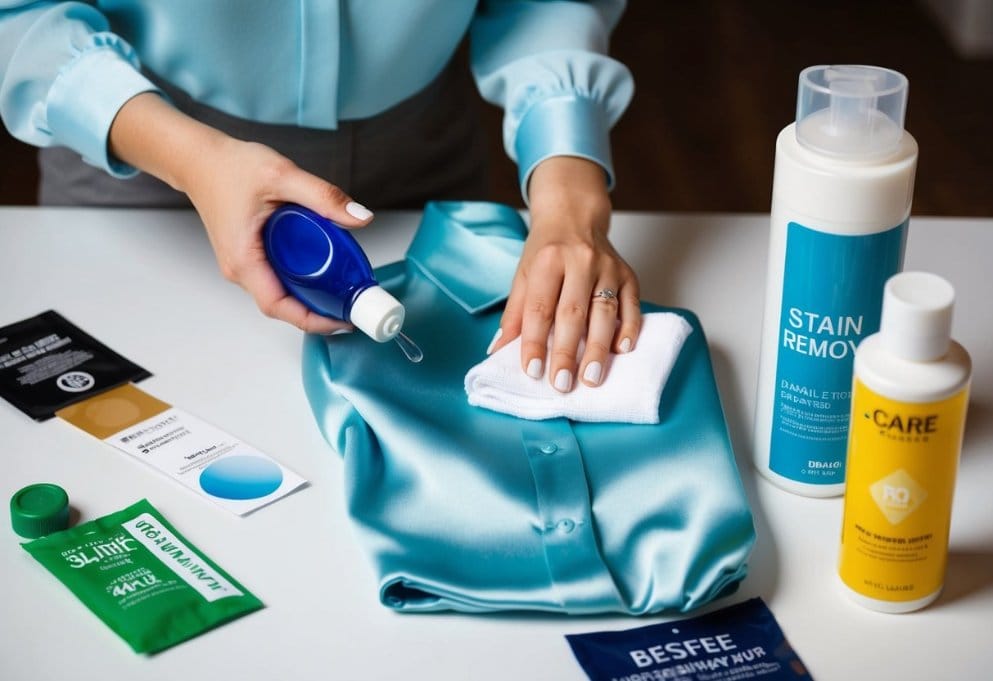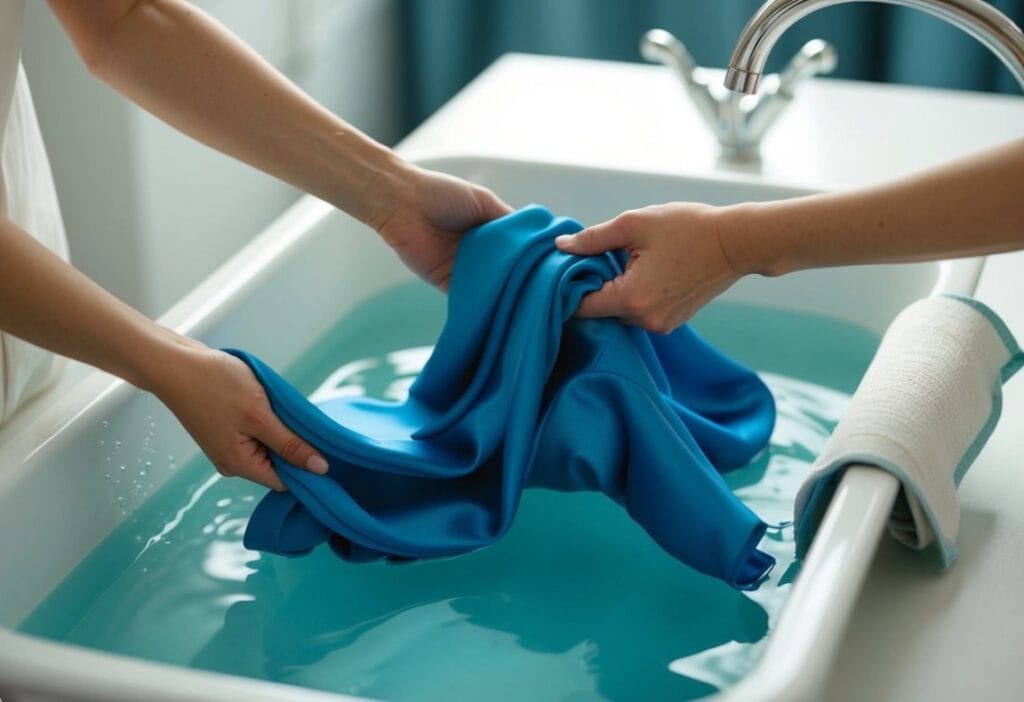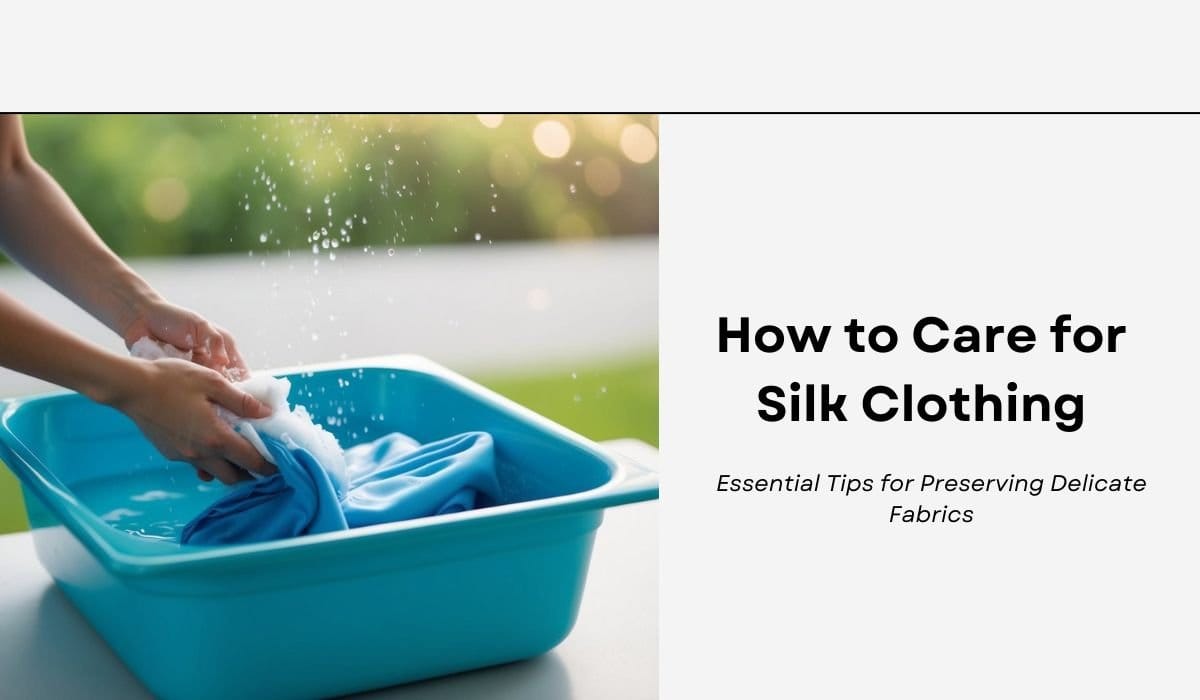Professional Care Secrets to Keep Your Silk Treasures Looking Exquisite Season After Season
Silk clothing exudes luxury and elegance, but it requires special care to maintain its beauty. Many people shy away from owning silk garments due to concerns about upkeep. With the right techniques, caring for silk is simple and can help your favourite pieces last for years.
Proper silk care starts with gentle handling and the right cleaning methods. It’s essential to check the care label before washing, as some silk items may be dry clean only. For washable silk, hand-washing in cool water with a mild detergent is often the safest approach.
Storing silk properly is just as important as cleaning it. Keep silk items in a cool, dry place away from direct sunlight to prevent fading and damage. With these basic principles in mind, you can confidently care for your silk clothing and enjoy its luxurious feel for years to come.
On This Page
Key Takeaways
- Silk requires gentle cleaning with cool water and mild detergent
- Proper storage in a cool, dry place helps preserve silk’s quality
- Regular care extends the life of silk garments significantly
Understanding Silk Fabric
Silk is a luxurious natural fibre prized for its softness and lustre. It comes from the cocoons of silkworms and has unique properties that set it apart from other fabrics.
The Nature of Silk Fibres
Silk fibres are incredibly fine and strong. They’re made of protein produced by silkworms as they spin their cocoons. These fibres are long and continuous, giving silk its smooth texture.
Silk has a natural sheen due to the prism-like structure of its fibres. This allows it to refract light, creating a shimmering effect. The fabric is also known for its ability to keep wearers cool in warm weather and warm in cooler temperatures.
One of silk’s key features is its high absorbency. It can absorb up to 30% of its weight in moisture without feeling damp. This makes it comfortable to wear in various climates.
Silk is also quite strong for its weight. It has good elasticity and can stretch up to 20% without breaking. However, it’s weaker when wet, which is important to remember when caring for silk items.
Identifying Quality Silk
High-quality silk has a soft, smooth feel and a subtle sheen. It should drape well and feel light yet substantial. When rubbed between your fingers, genuine silk produces a soft rustling sound known as the ‘scroop’.
To test if fabric is real silk, try the ring test. Pull the fabric through a ring – authentic silk should pass through easily. Synthetic silks often bunch up or resist.
Check the weave of the fabric. Quality silk typically has a tight, even weave with no loose threads or irregularities. Hold it up to the light – the weave should be uniform throughout.
Burn testing can also help identify real silk. Silk burns slowly and curls away from the flame, leaving dark, crisp ash. It smells like burnt hair. Synthetic fibres, in contrast, melt and produce a plastic-like odour.
Price can be an indicator of quality, as genuine silk is often more expensive than synthetic alternatives. However, always check the care label for fibre content to be certain.
Pre-Wash Care

Before washing silk garments, it’s crucial to take some important steps. These precautions help protect the delicate fabric and ensure the best cleaning results.
Checking the Care Label
Always start by examining the care label on your silk item. This small tag contains vital information about how to properly clean and maintain the garment. Look for specific washing instructions, such as ‘dry clean only’ or ‘hand wash in cold water’.
Some silk items can be machine washed, but only if the label permits. Pay attention to recommended water temperature and any warnings about bleach or fabric softeners.
If the label is missing or unclear, it’s safest to hand wash the silk or seek professional cleaning services. Don’t guess, as improper washing can ruin silk permanently.
Testing for Colour Fastness
Silk dyes can sometimes bleed, especially in darker or brighter colours. To avoid damaging your garment, it’s wise to test for colour fastness before washing.
To do this:
- Dampen a small, hidden area of the garment with water.
- Blot the spot with a white cloth.
- Check if any colour transfers to the cloth.
If you see dye on the white cloth, the silk is not colourfast. In this case, dry cleaning is the safest option. For colourfast silk, proceed with gentle hand washing or machine washing as per the care label instructions.
Remember, even if the silk passes this test, always wash it separately from other items to prevent potential colour transfer.
Washing Silk Clothing

Proper washing techniques help maintain silk’s lustre and softness. Cold water and gentle handling are key for both hand and machine washing.
Hand Washing Silk
Hand washing is the safest method for cleaning silk items. Fill a basin with cold water and add a small amount of mild silk detergent. Gently swish the garment in the soapy water for 3-5 minutes. Avoid rubbing or wringing the fabric.
Rinse thoroughly in cold water until all soap is removed. To remove excess water, place the silk item between two towels and press gently. Never twist or wring silk when wet.
Hang the item to dry away from direct sunlight or heat sources. Iron on a low setting while still slightly damp for best results.
Washing Silk in a Machine
Some silk items can be machine washed if the care label allows. Use a mesh laundry bag to protect the fabric. Select the delicate or hand wash cycle with cold water.
Add a small amount of silk-specific detergent. Avoid using regular laundry soap, as it can damage silk fibres.
After washing, remove the garment promptly. Do not use a tumble dryer. Lay the item flat on a clean towel to dry naturally.
Always check the care label before machine washing silk. When in doubt, hand washing is the safer option.
Drying and Ironing

Proper drying and ironing techniques are crucial for maintaining silk garments. These steps help preserve the fabric’s lustre and shape while preventing damage. Let’s explore the best methods for each process.
Drying Silk Without Damage
To dry silk safely, begin by gently squeezing out excess water. Never wring or twist the fabric, as this can cause wrinkles and stretching.
Lay the silk item flat on a clean, dry towel. Roll the towel up with the garment inside to absorb moisture. Unroll and repeat with a fresh towel if needed.
Next, place the silk on a drying rack or flat surface away from direct sunlight. Avoid hanging silk, as this can distort its shape. Ensure good air circulation to speed up drying.
Never use a tumble dryer for silk. The heat and agitation can severely damage the delicate fibres.
How to Iron Silk Correctly
Before ironing, check the care label to ensure the item can be pressed. Set your iron to the lowest heat setting or use the ‘silk’ setting if available.
Turn the garment inside out to protect its outer surface. Place a clean, white cotton cloth over the silk as a pressing cloth.
Move the iron gently over the fabric, avoiding long periods in one spot. Don’t use steam, as water spots can form on silk.
For stubborn wrinkles, increase the heat slightly, but be cautious. Test on an inconspicuous area first.
After ironing, hang the garment immediately to prevent new wrinkles from forming. Allow it to cool completely before wearing or storing.
Stain Removal Techniques

Getting stains out of silk requires care and precision. The right methods can save your garment without damaging the delicate fabric.
Treating Common Stains on Silk
For water-based stains, gently blot the area with a clean, white cloth to absorb excess liquid. Avoid rubbing, as this can spread the stain and harm the silk fibres.
For oil-based stains, sprinkle talcum powder or cornstarch on the spot. Let it sit for 30 minutes to absorb the oil, then brush off gently.
Wine stains can be tricky. Mix equal parts water and white vinegar. Dab this solution onto the stain with a soft cloth. Rinse with cold water afterwards.
For protein-based stains like blood or sweat, use a mixture of salt and cold water. Apply it to the stain and let it sit for 10 minutes before rinsing.
Using Appropriate Stain Removers
When choosing stain removers for silk, opt for gentle, pH-neutral products. Harsh chemicals can damage the fabric’s fibres and affect its lustre.
Silk-friendly stain removers include:
- Mild liquid soap
- Diluted white vinegar
- Enzyme-based cleaners (for protein stains)
Always test any product on a hidden area first. Apply the cleaner with a soft cloth, working from the outside of the stain inwards.
For stubborn stains, consider professional dry cleaning. Experts have specialised techniques and solvents for removing tough stains from silk without causing damage.
Remember to rinse the treated area thoroughly with cool water after stain removal. This helps prevent any residue from affecting the silk’s texture or colour.
Professional Silk Care

Professional care is often the safest option for delicate silk garments. Proper dry cleaning can extend the life of silk and maintain its luxurious feel and appearance.
When to Choose Dry Cleaning
Dry cleaning is recommended for silk items labelled “dry clean only”. This method uses special solvents to clean fabrics without water, preventing damage. Dry cleaning is ideal for:
- Structured silk garments like blazers or dresses
- Heavily embellished or beaded silk items
- Vintage or antique silk pieces
- Silk blends with other fibres
Professional cleaning is also wise for stubborn stains or water-spotted silk. Dry cleaners have specialised equipment to remove tough marks and restore silk’s lustre.
Finding a Reputable Silk Dry Cleaner
Choosing the right dry cleaner is crucial for silk care. Look for cleaners with experience handling delicate fabrics. Ask about their silk cleaning process and any special treatments they offer.
A good silk dry cleaner will:
- Inspect garments before cleaning
- Use silk-safe solvents and gentle processes
- Hand-press silk items to avoid shine marks
- Offer specialised stain removal for silk
Reputable professionals will also advise on proper storage and handling of silk between cleanings. They may provide garment bags or tissue paper to protect silk items.
Don’t hesitate to ask questions about their experience with silk fabric. A knowledgeable cleaner will be happy to explain their methods and address any concerns.
Storage Solutions for Silk
Proper storage is key to maintaining silk’s beauty and longevity. The right techniques protect silk from damage and keep it looking fresh.
Best Practices for Storing Silk
Store silk in a cool, dry place away from direct sunlight. Ideal conditions are 18-22°C with 50-55% relative humidity. Use breathable garment bags made of cotton or muslin to protect silk clothing from dust.
Hang silk items on padded hangers to prevent stretching. For delicate pieces, roll them in acid-free tissue paper before placing in storage containers.
Avoid plastic bags, which can trap moisture and lead to mildew. Cedar blocks or lavender sachets help repel moths naturally.
Clean silk thoroughly before storage to remove any stains or odours that could attract pests.
Maintaining Silk’s Quality During Storage
Check stored silk items regularly for signs of damage or pests. Air out silk garments periodically to prevent musty odours.
Fold heavy silk items like quilts or duvets with acid-free tissue between folds to prevent creasing. Rotate folds every few months to distribute stress evenly.
For silk scarves, roll rather than fold to avoid permanent creases. Store in drawers lined with acid-free paper.
Use silica gel packets in storage areas to absorb excess moisture. Replace these every few months to ensure effectiveness.
When removing silk from storage, allow it to hang freely for a day to release any wrinkles before wearing or using.
Frequently Asked Questions
Caring for silk garments involves specific techniques for washing, drying, and maintenance. Proper methods can help preserve the quality and extend the life of silk clothing.
Can one hand wash silk garments designated as ‘dry clean only’?
Hand washing ‘dry clean only’ silk items is possible but risky. It’s best to follow care labels, as silk loses 30% of its strength when wet. If attempting hand washing, use cool water and a gentle detergent.
Test for colourfastness on a hidden area first. Gently swish the garment in soapy water, then rinse thoroughly. Do not wring or twist the fabric.
What are the best practices for machine washing silk clothing?
Machine washing silk requires caution. Use a mesh laundry bag and the delicate cycle with cold water. Choose a mild detergent designed for silk.
Avoid mixing colours and keep the load small. Skip the spin cycle, as it can damage silk fibres. Remove items promptly after washing to prevent wrinkles.
How should silk clothing be cared for post-wash?
After washing, gently squeeze out excess water without wringing. Roll the garment in a clean towel to absorb moisture. Hang silk items to air dry away from direct sunlight or heat sources.
Iron silk on low heat while still slightly damp. Use a pressing cloth to prevent shine marks. Store silk in a cool, dry place away from direct light.
Is there a method for dry cleaning silk apparel at home?
Home dry cleaning kits can be used on silk, but they may not be as effective as professional cleaning. These kits typically include a stain remover and a dryer bag with cleaning cloths.
Follow the kit instructions carefully. For stubborn stains or valuable items, professional dry cleaning is safer and more reliable.
What steps should be followed to wash silk garments by hand?
To hand wash silk, fill a basin with cool water and add a small amount of silk-friendly detergent. Gently submerge the garment and swish it around.
Rinse thoroughly in cool water until all soap is removed. Avoid twisting or wringing the fabric. Blot excess water with a towel and lay flat to dry.
How can one maintain the quality of silk fabrics over time?
Regular care helps maintain silk quality. Brush off dirt and spot clean when possible to reduce washing frequency. Store silk items in breathable garment bags or cotton pillowcases.
Avoid hanging silk for long periods, as it can stretch. Rotate stored items periodically to prevent creasing. Keep silk away from direct sunlight and heat to prevent fading and damage.
Related Post: 10 Facts About Silk: Unveiling the Secrets of this Luxurious Fabric

